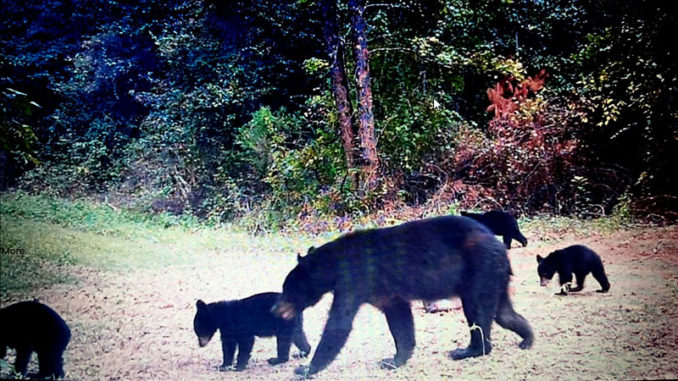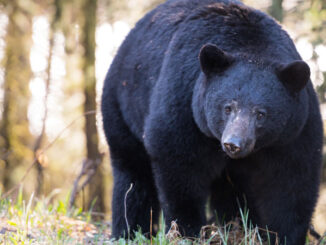
LWFC plans limited harvest of fast growing populations in the state
A black bear season may soon be enacted in Louisiana.
Louisiana Wildlife and Fisheries Commissioners announced a notice of intent (NOI) will be introduced in their November meeting, detailing such a season. The group announced their intention at their regular meeting Thursday, Oct. 5, in Baton Rouge. The meeting lasted well over four hours and covered several important topics. Many farmers, sportsmen and others who spend large amounts of time outdoors voiced the opinion that “it’s about time.” The first season is planned for 2024.
Growing concentrations of bears in certain areas are problematic and causing economic losses and declining hunting opportunities in some areas. And bears are being sighted in growing numbers where they have never been see before.
Commissioners gave no specifics on what the NOI entails but said bear harvesting will be performed in phases.
“The public is going to have to understand this is going to be gradual phases into harvesting,” Commissioner Joe McPherson, who spoke his opinion often at the meeting, said. “Everybody is not going to get to shoot the bear that is tearing up their deer feeder.”
John Hanks, Louisiana Department of Wildlife and Fisheries (LWDF) large carnivore program manager, called for the season to be a “conservative harvest in a limited area” during his informative speech about the black bears to commissioners.
According to Hanks, Tensas Management Area had the highest density of black bears in Louisiana’s four major population areas.
“All four of the populations are stable or growing at this point,” Hanks said.
Growing numbers of bears
A bear population, according to LDWF, consists of a “breeding population.” Bears who are breading, living and existing in a certain area.
“(Bears) are not moving there just on a whim,” Hanks said. “There are some populations that are more and some are less. Tensas population makes up 1/2 or more in total population.”
Conservation Reserve Program (CRP) and Wetland Reserve Easement (WRE) land played an important role in creating corridors between upper Atchafalaya and the Tensas area.
In 2023, LDWF estimated 1,212 bears were in the four populations, but Hanks stressed that number did not include all the bears. The number did not include young bears or cubs, but he felt the number did represent approximately 80 to 90 percent of Louisiana’s population. However, some areas of the state that aren’t included in the count have seen growing numbers of bears.
One device used by LDWF biologists to estimate population numbers were hair snares. Hair snares are two-strands of barbwire that are four feet apart. The strands have a bag of donuts positioned above them. When the bear comes through and visits, it leaves hair on the barb. Technicians check the hair snare weekly, collect hair, package it up and send it to a Canadian lab where they do a DNA analysis. The lab then sends results to Dr. Joe Clark in Tennessee, beer population expert, and he runs a population model. The hair snares are also cleaned weekly.
Additionally, bears are collared and biologists count cubs in the dens to get estimates.
“Most bears are in that Mississippi Alluvial Valley and the Atchafalaya Basin,” Hanks said.
A conservative harvest
Previous legislation was introduced by Sen. Stewart Cathey Jr. of District 33 and Rep. Neil Riser of District 20, calling for a black bear season, but the bill was not run at the request of the LDWF.
Cathey, who attended the Oct. 5 meeting, said he wanted the commissioners to implement a season instead of lawmakers having to step in. In his speech to commissioners, the senator requested “responsible conservation” and to make tags transferable, meaning if a landowner receives a tag he could give it to someone else.
“I had the privilege of addressing the Wildlife and Fisheries Commission regarding the need for a bear season,” Senator Cathey said after the meeting. “Last year, I had legislation to create the season, but due to legal challenges, did not run the bill. Instead I chose to work with the LDWF as we establish the rules and regulations for the season. As a result of this partnership, I am proud to announce that we will begin bear season in 2024. The Black Bear has become a nuisance in many parts of the state and disrupted hunters and farmers. I am excited to have played a part in this new season and look forward to next season.”
John Madden, a Tensas and Madison parish landowner, said he saw his first bear on his land in 2002 but “now they were a common occurrence.”
Madden also told of a recent deer hunt where he saw no deer but saw two bears. Last year, he saw eight bears while sitting on his porch, grazing in a nearby pecan orchid. Madden’s comments were typical of those shared on a regular basis by hunters, landowners and farmers.
“We can certainly have a conservative harvest in a limited area,” Hanks said.
CWD Control Area regulations
Another major issue facing Louisiana sportsmen is CWD. At the meeting, the LDWF once again expanded the CWD Control area to include a portion of East Carroll Parish in Henderson Island. Henderson Island is on the east side of the Mississippi River but still in Louisiana. It is majority private hunting island.
“We received a CWD positive deer in Issaquena County, Mississippi,” said Johnathan Bordelon with LDWF. “The significance of Issaquena County is the actual location of the index case, meaning the very first detection in the state of Mississippi. The detection occurred in 2018.”
All supplemental feeding, including mineral or salt licks, is prohibited. The purpose of this feeding ban is to reduce the potential for the spread of CWD through artificial congregation of deer at bait sites. The use of approved bait not normally ingested by deer for feral hog trapping will be allowed.
The export of cervids, cervid carcasses or parts of cervid carcasses originating within CWD Control Area is prohibited, except for: meat that is cut and wrapped; meat that has been boned out; quarters or other portions of meat with no part of the spinal column or head attached, antlers, clean skull plates with antlers, cleaned skulls without tissue attached, capes, tanned hides, finished taxidermy mounts and cleaned cervid teeth.
Export exceptions for taxidermy, which require a permit, have been established. The deer head waiver permit must be completed before moving the deer head outside of the CWD Control Area to a taxidermy business.
